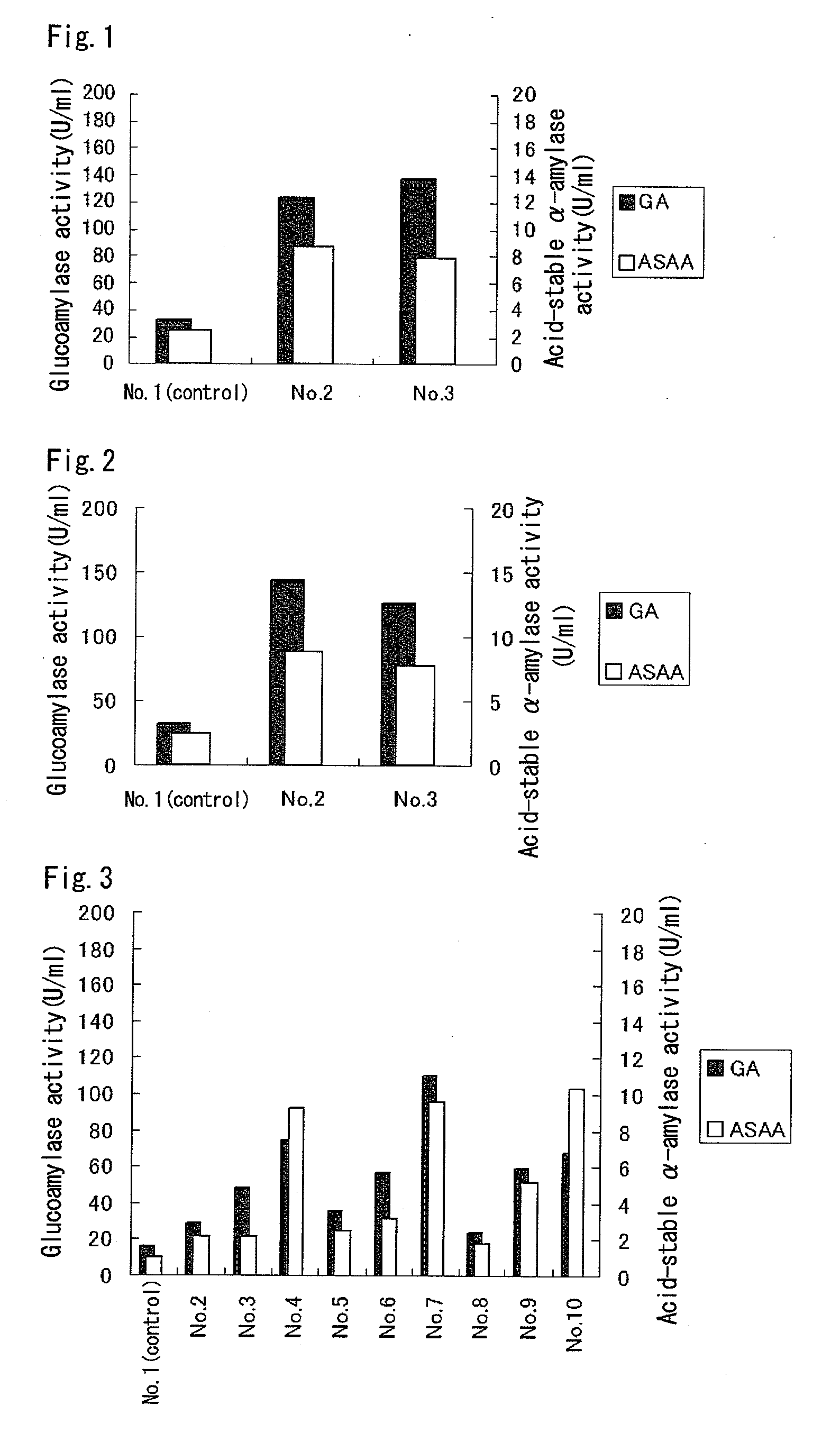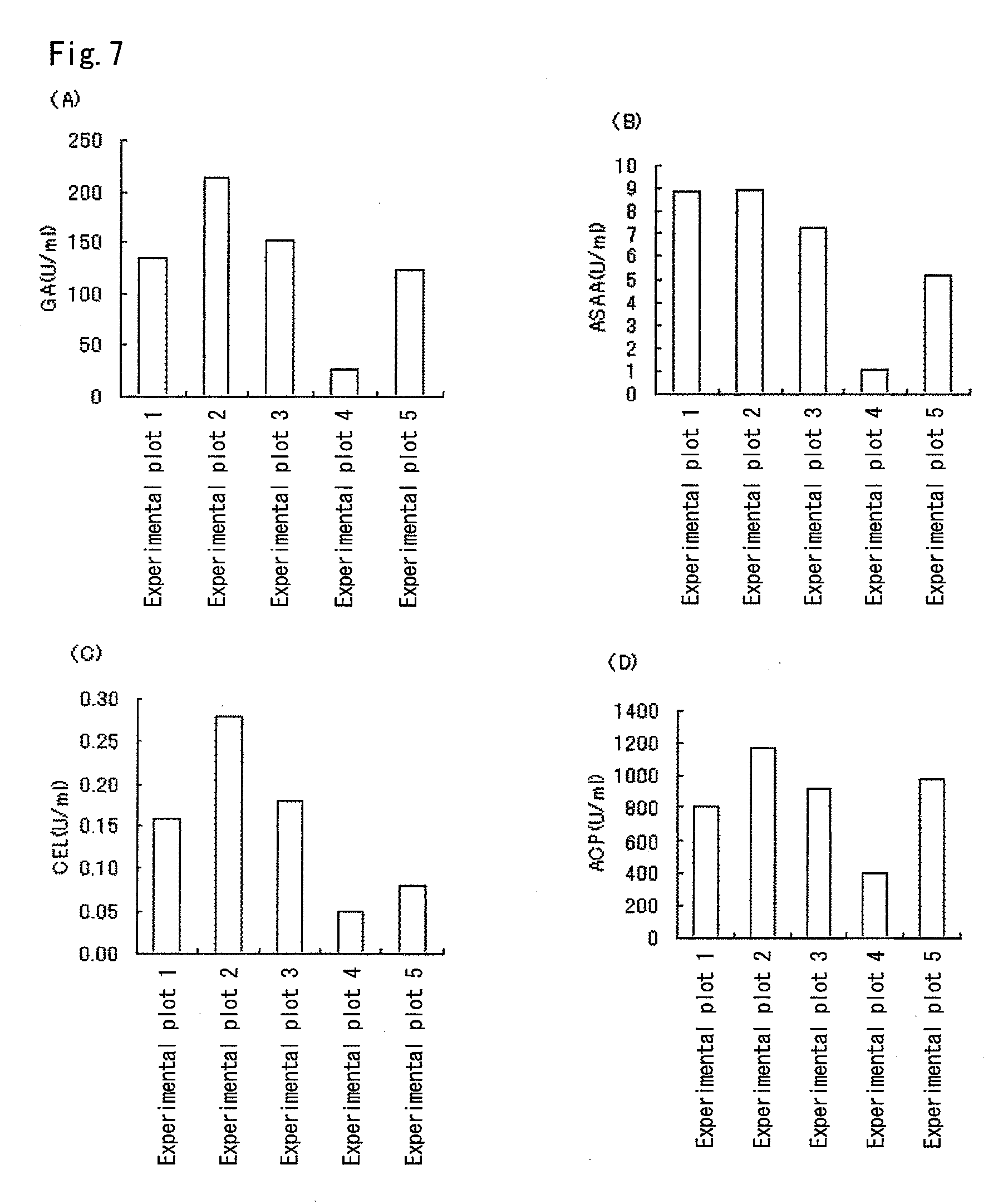Method of producing liquid koji
a technology of liquid koji and koji molds, which is applied in the field of liquid koji production, can solve the problems of difficult to make even the factors, unsuitable large-scale production of solid culture methods, and complicated solid culture methods, and achieves the effects of improving the productivity of amylolytic enzymes, high yield, and general improvement of the productivity of enzymes produced by koji molds
- Summary
- Abstract
- Description
- Claims
- Application Information
AI Technical Summary
Benefits of technology
Problems solved by technology
Method used
Image
Examples
example 1
Addition of Inorganic Nitrogen Substance in Production of Liquid Koji
[0114]The effect when potassium nitrate as inorganic nitrogen substance was added to the liquid medium was investigated as described below.
[0115]At first, three types of liquid media were prepared, in which crude barley was added respectively to water without addition (control), to that with 0.2% (w / vol) potassium nitrate, and to that with 0.4% (w / vol) potassium nitrate so that the amount of the crude barley was adjusted to 2% (w / vol).
[0116]Each 100 ml of the liquid media was placed in a 500-ml baffled conical flask and was autoclaved, and white koji molds (Aspergillus kawachii IFO4308) cultured in advance in liquid medium was inoculated so that the amount thereof was adjusted to 1% (v / vol) for the liquid medium. As the crude barley, 95% polished Stirling barley made in Australia was used (This is basically true in the examples herein below).
[0117]Culture was then conducted for 48 hours at a temperature of 37° C. a...
example 2
Addition of a Plurality of Inorganic Substances in Production of Liquid Koji
[0120]The effect when a plurality of inorganic substances were added was investigated as described below.
[0121]Potassium nitrate or sodium nitrate as inorganic nitrogen substance, and potassium dihydrogen phosphate as inorganic salt were added to water in the compositions shown in Table 2. The addition amount of the sodium nitrate was calculated out from the molar concentration corresponding to 2.0% of potassium nitrate, that is, 20 mM, and was blended 1.7% so that the nitrate ion concentrations become the same. Water without inorganic nitrogen substance nor inorganic salt was used as the control.
[0122]To the raw material water prepared as described above was added crude barley as culture raw material in a concentration of 2% (w / vol), and 4 types of liquid media was prepared. Liquid culture of the white koji molds was conducted under the same conditions as that in Example 1. After that, glucoamylase activity...
example 3
Addition of Yeast Cells or Yeast Autolysate in Production of Liquid Koji
[0124]Liquid koji was produced by using liquid medium to which yeast cells or yeast autolysate (i.e., yeast extract) was added.
(1) Preparation of Yeast Cells or Yeast Autolysate to be Added
[0125]Beer yeast recovered from a step of brewing beer was treated under the following conditions, to thereby obtain beer yeast cells and yeast autolysates (1) and (2) to be used in the production of liquid koji.
[0126]Yeast cells: The beer yeast cells obtained by dehydrating beer yeast to about a water content of 70% by means of centrifugation at 5,000×g for 15 minutes.
[0127]Yeast autolysate (1): The yeast autolysate obtained by suspending beer yeast cells in an equal amount of water and treating the mixture at 52° C. for 18 hours.
[0128]Yeast autolysate (2): The yeast autolysate obtained by suspending beer yeast cells in an equal amount of 1% lactic acid and treating the mixture at 52° C. for 18 hours.
(2) Preparation of Liquid...
PUM
| Property | Measurement | Unit |
|---|---|---|
| culture time | aaaaa | aaaaa |
| temperature | aaaaa | aaaaa |
| culture temperature | aaaaa | aaaaa |
Abstract
Description
Claims
Application Information
 Login to View More
Login to View More - R&D
- Intellectual Property
- Life Sciences
- Materials
- Tech Scout
- Unparalleled Data Quality
- Higher Quality Content
- 60% Fewer Hallucinations
Browse by: Latest US Patents, China's latest patents, Technical Efficacy Thesaurus, Application Domain, Technology Topic, Popular Technical Reports.
© 2025 PatSnap. All rights reserved.Legal|Privacy policy|Modern Slavery Act Transparency Statement|Sitemap|About US| Contact US: help@patsnap.com



